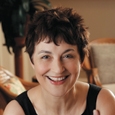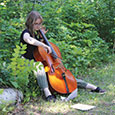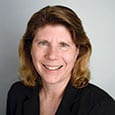In the spring of 1992 flutist Stephanie Jutt, professor of flute at the University of Wisconsin-Madison, asked a friend, then doctoral pianist Jeffrey Sykes, what he was doing over the summer. They both decided they were not playing enough, and then and there, the Bach Dancing and Dynamite Society was born. They created a summer chamber music festival like no other to show audiences that classical music could be serious and fun at the same time. Their programming includes beloved classics as well as music that is hot off the press by young composers. They wooed four musician friends with their vision (and margaritas, frozen custard, and lunches at a favorite restaurant), and all agreed to perform for free to get the festival off the ground. Jutt secured free concert hall space, and at the end of each concert, they put out a cello case for donations. To everyone’s surprise they earned over $1,500 during the first concert weekend. This covered everyone’s travel expenses, with a bit left over for the next year. Every summer since, for the past 20 years, Bach Dancing and Dynamite Society has finished in the black and now has an annual budget well into six figures. Their success was not beginner’s luck but the direct result of Jutt’s experiences and artistic entrepreneurship.
What were your first experiences as a professional musician?
When I was 18, I decided to postpone college after graduation from Interlochen Arts Academy and move to San Francisco. At that time there was an explosion of street musicians in San Francisco, and I made a pretty good living playing in a variety of ensembles including a Baroque music trio, a flute and harp duo, a flute duo, a street orchestra full of Juilliard dropouts, jazz with saxophonist John Handy’s ensemble, and a rock band. I also studied privately with the great Merrill Jordan, and after two years enrolled in San Francisco State University to study with Lloyd Gowen, piccolo player in the San Francisco Symphony. Gowen had studied with Merrill Jordan himself and also at the Curtis Institute with William Kincaid.
For a while I was a dance major because I had played mandolin and piccolo in a Russian dance band and was fascinated by the complex movements of ethnic dance styles. The legacy of this training was that movement and rhythm became key to my understanding of music. During this period I also learned to avoid over-rehearsing, so I would not lose the spontaneity of the unexpected.
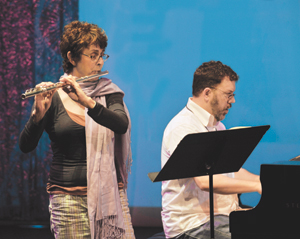 Where did you go next?
Where did you go next?
I did not want to be just pretty good; I wanted to play at the highest level I could achieve. I was accepted at the New England Conservatory and began studies with James Pappoutsakis, second flutist of the Boston Symphony. Pappoutsakis was not a soloist but rather an impeccable and introspective artist. From him I learned to create the colors and nuance of playing the flute in the French style. I worked very hard to master technique. After a year I received a full scholarship to perform in the first New England Conservatory scholarship woodwind quintet. I went on to earn my master’s degree under the guidance of a very different soloistic player, Paula Robison. After graduation I completed my education by traveling to Vermont for one year to work with the Marcel Moyse.
After graduating with my bachelor’s and master’s degrees, I moved to New York, where I free-lanced and discovered a love of opera. As I listened from the vantage of the orchestra pit, I learned to play more like a singer. (Marcel Moyse liked to compare opera divas during lessons.) On the spur of the moment I took a job playing principal flute for the Hong Kong Philharmonic. Living in Hong Kong for a year was a fabulous experience. (They served warm soy milk at intermission, and we traveled all over Asia with the London Ballet.) I found I missed New York, however and returned to a life of recitals, orchestra and chamber music. I was also interested in new music and the jazz scene and soon married a bassist who played in the Bill Evans Trio. Evans loved playing classical music, especially the J.S. Bach sonatas, so we played together for fun at home. Evans played Bach beautifully, and his phrasing and voicing of the chords gave me a new understanding of Bach’s harmonic and rhythmic language. I went on to have two children, write a one-woman theatrical show, which was called Private Lessons, work as the production coordinator for Nonesuch Records for one year, and start the Blue Ridge Music Festival.
How did you end up in Wisconsin?
While at a performance of my one-woman show in Ohio, I ran into Les Thimmig, a well-known jazz and classical player/composer. He mentioned that the University of Wisconsin-Madison School of Music had an opening for flute professor and suggested I apply. I was not optimistic because I had no previous college teaching experience, but I soon received a phone call from him with an invitation to come to Madison for an audition. I had two days to get ready. My little boy was only a few months old, but somehow I pulled together a performance that they liked and became a professor at UW-Madison. At the time I had only been through Madison on a New York City Opera tour, and thought that Wisconsin was west of Minnesota.
I love working with my students. They are endlessly interesting and incredibly alert, genuine seekers of knowledge. I try to impart the fire and passion of playing music and help them realize the importance of having a great fervor in everything they do, as well as a true understanding of style and tradition.
How are students today different from when you were a student?
I find that students who come to a state university and have not been part of an elite training program are often less prepared than they should be for advanced flute studies. Because there is less musical training available in public schools today, there is an unfortunate divide between those who can afford additional music lessons and those who cannot. I try to spot raw ability at auditions and will teach any talented student who is willing to work. Sometimes it takes three years to train a student to play with the proper technique, embouchure, and knowledge of style that I believe I had as a first-year college student.
What do you focus on with students?
I believe that you have to look at where the student is and start with the basics, including what the arms, shoulders, neck, and head feel and look like, and whether there is tension in the throat. Other areas include breathing, articulation, fluidity in the fingers, vibrato, and rhythm. I look at phrasing, and whether a student is conscious of style, history, character, and harmonic movement. Most importantly, I determine whether the student is self-motivated and curious about the world. Teachers of all subjects have ‘taught to the test’ over the last twenty years, and often it robs students of their natural curiosity. I absolutely love Bartók, for example, so I listen to everything he ever wrote, the orchestral works, the string quartets, and so forth. Today students only want to know, if they will be tested on something or what they need to do to get an A in a course. I blame an educational system that takes every creative bone in a child and turns it into a test score. It is really criminal. I encourage students to explore and love music the way I do, while still holding their noses to the grindstone and making them learn technique at a pretty relentless pace.
What is your approach to programming chamber music concerts?
I think our attitude is summed up in our motto, Serious Fun. We play all types of music from lighthearted, fluffy pieces to the most serious and profound, but our habit of keeping a light touch on it all has served us well. There is nothing about classical music that says players have to be serious or stodgy. We want to make concerts fun and challenging for the audience. Listeners should be on the edge of their seats, emotionally, and musically. We want to share what the music means to us.
As audience members, we often have a museum mentality about classical music. Concert programs are filled with a line-up of masterpieces, and the audience is expected to approach them in awestruck silence. The museum mentality is a perfect formula for self-seriousness. A great part of the problem is that musicians tend to play the same old standards over and over, and newly written music is relegated to special concerts. We should always remember that the great masterpieces were new themselves once. Concert presenters of those days took a chance on Beethoven, Brahms, and Debussy, and many people did not like what they heard, at least at first.
Modern concert presenters are too often afraid to take a chance on a piece that maybe people will not like. People should decide what they do not like before they can know what they do enjoy. New music should breathe the same air as old music. They should be heard side-by-side, given equally committed performances, and compared directly to one another. Sometimes new pieces are terrible, but sometimes they can express an emotion or mood better than any piece has yet done. That is thrilling when it happens. Would you prefer to go to a museum that features just one type of art, or one where there are many styles side by side? I definitely prefer the latter, and I prefer a concert with Brahms next to Ranjbaran, and Rebecca Clarke as well as Felix Mendelssohn. I find a succession of masterpieces can easily dull the palatte to what is special and particular to each one. I am not saying don’t program masterpieces, just mix it up a little.
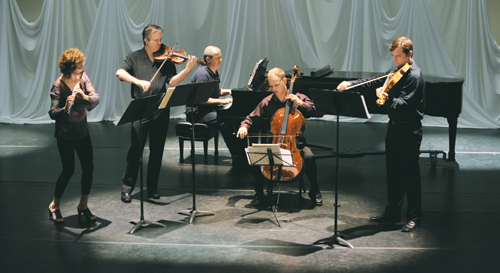
Why should people attend chamber music concerts?
The chamber music repertoire has much of the greatest music ever written, and there is absolutely nothing in the world like sitting four feet away from a great musician in a small ensemble. The audience is part of an intimate musical conversation; it is an utterly different experience to hear music live. As an intrepid concert goer, I can tell you how much I love Bela Fleck on a recording, but it is a hundred times better live. Chamber music, or really all classical music, is truly on the endangered list. It is not taught in many schools anymore as instrumental programs are cut. Most people do not listen to it on the radio either, so it is tough to encourage people to buy a ticket. They simply do not know what they are missing. Once we get people in the door, they tend to love it and come back again and again.
With our chamber festival we talk about the music to explain the language of the composer and context of the works. We make the publicity as inviting as possible and offer plenty of variety. There is always fun stuff at our concerts; we give away humorous, themed door prizes, invite mystery guests to perform, and write crazy novelty pieces. This creates a relaxed atmosphere. When people feel free to laugh, they are more open to the emotional possibilities of the music. In the great Shakespeare plays, the comedies have tragic moments, and the tragedies comic moments. What would Hamlet be without Rosencrantz and Guildenstern?
Over twenty years we have learned that if we set up a piece of music correctly, the audience will go just about anywhere with us. One of the latest catch phrases is engagement before information. If we stand in front of an audience and blab on about Bach’s use of double counterpoint and the intricate sonata form of a Beethoven trio, the audience will listen intellectually, but it is the emotional and spiritual power of music that makes people want to listen. All of the crazy things we do, and we have had some really crazy ideas in twenty seasons, are designed to foster that kind of listening. Over the years, we have gotten more sophisticated in how we do this.
This past summer our season title was Bach to the Future. While we played traditional repertoire from Bach, the concerts also had a focus on the future. Each program also has a separate concert title. The first was The Empire Strikes Bach. Pianist, Jeffrey Sykes and I wore Luke Skywalker and Princess Leia costumes and light sabers. At the beginning of the concert I ran out onstage in my costume (complete with gigantic Princess Leia hair buns), looking terrified, and said, “Help me Obi-wan, you’re my only hope!” Jeffrey appeared at the back of the hall in his Luke Skywalker getup and ran onstage, yelling, “Never fear, Princess Stephaleia, I’m coming to rescue you!” I replied enthusiastically, “Oh, Luke Sykeswalker, the Forte is strong within you!” Everyone laughed at that.
Another season, we created an all-French concert called Monet’s Garden with a depiction of Monet’s garden that was created by a local florist and baker, complete with a running stream and beautiful dragonflies made from cookie dough. The audience could walk through the garden and eat the flowers and the dragonflies. The whole concert hall had a heavenly fragrance from the thousands of arranged flowers.
How do you come up with themes for your chamber music festivals?
The Bach to the Future theme came about because we wanted to feature Bach (he is part of our name), and we thought we would indulge ourselves in a bounty of Baroque playing. Our audience loves Bach and is always asking for more, so we featured an significant piece by a member of the Bach family on each concert this year. We also include important composer anniversaries in the programming.
Last year we chose the theme Novel Obsessions and named every concert title after a famous novel. We designed the programming around that theme, and actors read specially chosen monologues from each book during the concert. Sometimes we really have to stretch, like when we created the repertoire for Voodoo Love Mint. We love to daydream and let ideas bubble up, and then put them into motion.
In our second season we performed the Messiaen Quartet for the End of Time. It is a long and challenging work for a general audience, so we had readings between the movements of short poems and stories that related to the content of the movement. It added about five minutes to an already long piece. One reviewer commented that Messiaen’s music did not need this help, and we should dispense with the readings in future performances. He went on to say that it was an outstanding performance and that rarely in his career had he been at a performance of such a challenging piece in which the audience paid such close attention. The quality of the silence and the listening was striking, he mentioned, and went on to say: ‘quality commands attention, and this event proved it.’ Looking back on that performance, I think it is possible that the readings between the movements contributed to the quality of the listening. The audience may have paid such close attention because they were set up to have a powerful experience with this challenging music. When I listen to the performance today, the playing was not our best, but I find that the readings put the listener immediately into the frame of mind to hear what Messiaen had to say.
What is the theme for 2012?
The theme for next year is: Mixology. Mixologists are usually bartenders who make up new cocktails with very creative ingredients. For a 21st coming-of-age season, we thought that would be perfect. I am very interested in technology and would like to continue using jumbo-trons, film and set design, as well as collaborations with dance, theater and visual artists. Developing these themes is the most seriously fun thing in the world.
What is the instrumentation for the chamber festivals?
Every week is different; we have anywhere from three to fifteen players. It all depends on the repertoire that we choose, which of course depends on the budget as much as anything else. If there is a small budget, we save money by playing small ensemble pieces and splurge with one week of large ensemble pieces. This year, we presented J.S. Bach’s hilarious “Coffee Cantata.” Other big performances have included Aaron Copland’s Appalachian Spring and double string quartets plus bass to perform Vivaldi’s Four Seasons and Astor Piazzolla’s Four Seasons of Buenos Aires.
Who are your favorite composers?
I heard a quote from Gunther Schuller once: “There are only two kinds of music: good music and bad music.” If it is good music, I love all kinds and do not discriminate between styles, eras, genres, or instrumentation. Without a doubt I love the great Romantic composers, Brahms, Schubert and the like. I have played many of their works in transcriptions and created a new set of Brahms transcriptions of both of the two clarinet sonatas and the A Major violin sonata.
In the Bach Dancing and Dynamite festivals, we try to mix up the old and the new, the popular and the obscure. Two of my favorite obscure composers are the French composer Melanie Bonis (1858-1937) and the Czech composer Erwin Schulhoff (1894-1942). Melanie Bonis was not well known simply because she was a woman composer in a very cloistered bourgeois society. Erwin Schulhoff lived in the mid-twentieth century and much of his music was lost for a long time because he was a Czech Jew who died in a concentration camp. Thankfully, there is a resurgence of interest in his music, and we have performed much of it. Other favorite kinds of music include everything from Lady Gaga to Radiohead to Portuguese Fado singer Mariza and Tupac Shakur. And of course, I am a great fan of my daughter, Francesca Esmé, a great young jazz singer in Brooklyn.
If someone asks me what my favorite music is, it is almost always the piece I just played. Musicians tend to stay in the moment and throw themselves into the job at hand. I simply love being a musician and feel incredibly lucky to have a life in music. It has been creative and a bit offbeat, and I have been able to play music at a very high level for a long time. Although I would have loved to play in the Boston Symphony, we all have an important contribution to make wherever our music takes us.
How to play chamber music
1. Listen, listen, listen. Listen from three perspectives – to yourself, from the center of the ensemble, and from the audience’s perspective. Pay attention to all three roles.
2. Learn all the other parts. Study the score, and find the major transitions and awkward moments that you will have to finesse through cueing and communication.
3. Learn to look up over your stand at other players without losing your place. Practice this at home before working with others. This is important so that you are able to communicate effectively and watch cues.
4. Learn how to conduct with your flute. The flutist often has to act as conductor and help start and stop an ensemble, among many other things. Learn to make clear, efficient cues with your flute.
5. Learn the intonation tendencies of your instrument and of the other instruments in the ensemble. For example, clarinets tend to be sharp in the lowest register, while flutes tend to be flat. Correct your intonation problems first and then work on the intonation of the ensemble. Use drones to help if you are not yet adept at hearing the problems.
How to start a music festival
1. Performers: Pick people you enjoy playing with or find the most accomplished players in your area.
2. Venue: Look for a donated concert space that has a good-quality tuned piano.
3. Timing: When planning events, look at what else will occur at the same time. Think about whether there is a niche you can fill.
4. The Hook: Come up with something new or different that will bring in audiences. An exciting idea may create interest and free publicity from local media.
5. The Audience: This important point affects the others, including where you perform and the marketing plan. Think about how you can contribute to the community, and don’t forget such groups as hospices, prisons, hospitals, boys and girls clubs, and retirement homes.
6. Divide the Work: Know your strengths (publicity, programming, grant writing, etc) and find partners who have different skills.
